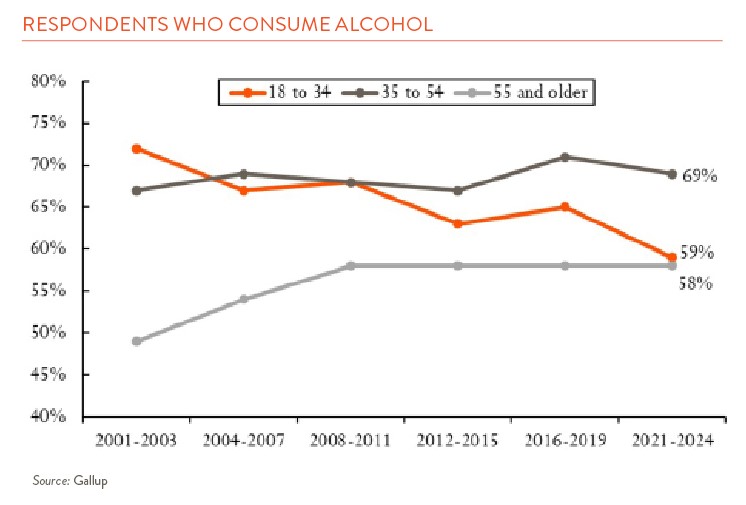Alcohol purveyors suffered through a tough start to 2025. Dry January, a campaign to get people to abstain from alcohol for the first month of the year, continues to gain momentum with 75 million American adults expected to have tried the challenge this year. Former U.S. Surgeon General Dr. Vivek Murthy piled on with a recent advisory that “alcohol is a well-established, preventable cause of cancer” and called for stronger warning labels for alcohol containers.
Both events occurred against a backdrop where alcohol consumption, a long-mythologized rite of passage to adulthood, declined among young people over the last two decades. Gallup recently released a poll that showed that the percentage of Americans ages 18 to 34 who say they drink has fallen from 72% in 2001-03 to 59% in 2021-24, just above the oldest cohort but well below the 69% for Americans ages 35 to 54 (see chart below). The trend toward less youth drinking accelerated over the last decade as more members of Gen Z (born between 1997-2012) entered adulthood and Millennials (born between 1981-1996) exited college into the workforce.

Multiple factors could explain this trend including health concerns, the rise of alternatives, and different social patterns. 65% of young Americans now view alcohol as unhealthy, up from 30% in 2001, and well above similar thinkers in the middle age (37%) and 55+ (39%) cohorts. Almost all the youngest group think that average drinkers should cut back on drinking (67%), well ahead of ages 35-54 (51%) and above 55 (52%). The data also reveal a strong anti-drinking contingent of roughly 20%-23% of Americans.
The fast rise of alcohol alternatives such as non-alcoholic beer, mocktails, and marijuana and their social acceptance could also contribute to the decline in youth drinking. While still illegal at the federal level, the Pew Research Center estimates that 79% of Americans live in a county with one dispensary, and Gallup notes that 68% of Americans now believe that marijuana should be legal, up from 34% in 2001. While approximately half of younger and middle-aged Americans identify as lifetime users, respondents ages 18-25 were more likely to have partaken in the last year and the last month according to the 2023 National Survey on Drug Use and Health.
Some attribute the lower consumption of alcohol by young people to the rise of loneliness or lower levels of social interactions. Others have also speculated that the change could be explained by younger people trading real life experiences for online activities, which generally generate less social peer pressure compared to going out to a bar or club. A recent New York Times article makes a related point discussing the possibility that progress in drug and alcohol addiction might be related to people turning to “digital drugs.” Finally, with remote work, post-work drinks no longer hold the same prominence.
While health advocates cheer the lower level of drinking, the data show these trends can revert over time. In the 1990s, per capita consumption fell to just under 2.5 gallons per year from nearly 3.3 gallons in 1980. Several factors likely impacted this decline, including a higher legal drinking age and the increased acceptance of alternatives, including marijuana. But that low was not sustained, with alcohol consumption rising steadily to 2.85 gallons by 2021, a level last seen in 1988.
Trends to watch moving forward include the broader influence of Gen Z’s attitude toward alcohol consumption. Beverage companies will likely continue to innovate with new drinks and formats to capture the younger generation’s—and other teetotalers’—dollars. Another potential impact on consumption would be a harsher warning label like tobacco packaging.